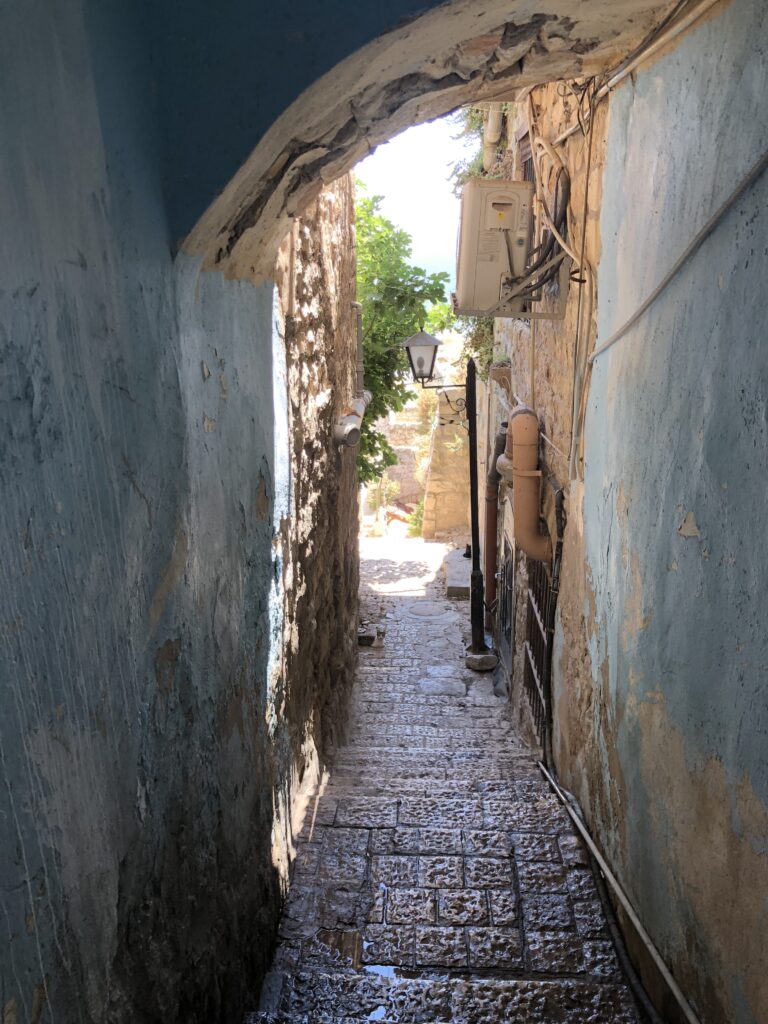By Joseph B Yudin PhD
The ancient Jewish mystics sought sanctuary here in the small secluded Galilean villages when the Romans outlawed Judaism after the destruction of the Temple in Jerusalem 2000 years ago. It is indeed their tombs that dot the Galilean countryside. Tradition has it that one great sage, Rabbi Shimon bar Yochai and his son Rabbi Eliezer, arch enemies of the Romans, hid in a cave that still exists on the outskirts of the village of Peki’in. In the year 135 CE, Rabbi Shimon had said that he would not adhere to Emperor Hadrian’s declaration that Bible study would be forbidden, that circumcision would be outlawed (being that the Jews considered circumcision to be the covenant between them and God and ordination of Rabbis would be banned.
Rabbi Shimon was in his bath when his son Rabbi Eliezer burst in and declared that the romans are at the village gates, looking to crucify him. Rabbi Shimon had to make a choice: Run to his bedroom get dressed and run out the front door, or run to his study, grab the Torah (the first five books of the Hebrew Bible in scroll form, also called the Five Books of Moses) and hop out the window, fleeing into the forests of Mount Meiron. He chose the latter. The two came upon a deep and dark cave. Outside of the cave there grew a lone carob tree next to a small spring. It is from this tree and spring that the rabbis sustained themselves during the Bar Kochba Revolt against Rome and for 12 years until Emperor Hadrian had died and his sentence commuted.
Tradition holds that Rabbi Shimon would meditate on the Torah inside the dark cave by a lone, tiny olive oil lamp, and it is here where he received a divine revelation, the word of God, unlocking the secrets of the universe. The great rabbi proceeded to write down what he received from the divine presence in that dark cave into a manuscript he named the “Book of Splendor” or “The Zohar”. The Zohar is the teachings of Rabbi Shimon and his students which forms the basis of Jewish Mysticism called in Hebrew ‘Kabbalah” whish literarily means “That which was received”.
Across the valley from the Tomb of Rabbi Shimon bar Yohai on Mount Meiron, and the cave to which he wrote the Zohar, is the city of Tzfat, one of the four cities in the Land of Israel considered holy by the Jewish people the others being Hebron where the Patriarchs and Matriarchs are buried, Tiberias where half of the Talmud was codified and Jerusalem where both Temples to the God of Israel once stood. Wander you way through the blue and white ancient alleyways and narrow corridors of Tzfat’s Artist Colony. Blue and white are said to be the colors of Heaven according to Rabbi Joseph Caro who lived here in the 16th century. You will find his synagogue here between the shops on the main drag in the artist colony, where he wrote the Shulchan Aruch (The Set Table) which condensed known Jewish law into one easy to read, everyday use book for everyone to read and understand. Much of the art in these shops represent symbolize in the Kabbalah and other ancient Jewish folklore, tradition and superstition, some of which we discuss below.
At the heart of the Old City of Tzfat, rests a 500 year old synagogue that bears the name of the Rabbi Yitzik Luria, also known as “the Holy Ari”. Before this house of worship was built nearly 500 years ago, there stood here an orchard. The Ari used to come to this former orchard, now this synagogue, every Friday late afternoon with his students, singing praise to God in prayer that the Messiah would show himself. After prayer he would give a lesson, often about Kabbalah and the Zohar.
When entering the Synagogue of the Holy Ari, the “bema” or stage is at the center of the edifice, being that the synagogue was built by Jews fleeing the Spanish Inquisition in the late 15th century. These “Sephardic” (Spanish) Jews would read from the Torah on this stage and wanted the Torah to be in the midst of the surrounding congregation during prayer. It is here where Rabbi Shlomo Alkebetz, influenced by the biblical book the Song of Songs, penned the Friday dusk prayer Lekha Dodi, sung today in every Jewish congregation across the globe as the Sabbath is beginning, reciting in joyous song “Let us go, my beloved, to greet the Sabbath bride”.
In the Zohar we read a name for the Lord not ever mentioned before in Holy Scriptures: “Ein Sof”, meaning “the Infinite One”. The Ari taught that when Ein Sof, God’s name before creation, began to create the universe but His infinite being, His light, His energy, was everywhere and all compassing, leaving no room for anything to be created. God therefore began to withdraw unto Himself to a single point of Divine Essence, condensing His light, his energy, into one point of light. God then all at once emanated forth rays of light made up spheres of color, and these spheres were sent out to all corners of the universe. This, according to the Kabbalistic Rabbis of Tzfat, is the light that was created by God on the first day.
Check out some of the other synagogues in Tzfat, especially the Abuhav Synagogue, perhaps the most beautiful and tranquil in the city. Then make your way back to your car but try to check out some shops in the Artist Colony. The storekeepers will gladly explain the symbolism and significance of the art, jewelry and Judaica. Of special note is the Tallis factory at the Canaanite Gallery and surrounding stores in the Figtree Courtyard, and don’t miss the Yemenite eatery where Ronen cooks up a traditional dish of Lachuch (sort of a pizza) right in front of you. Simply delightful!


